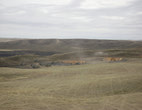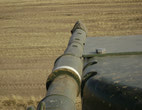Exercise DESERT RAM – Phase II: B Sqn TF 3-09 Road to War:
Written By: Capt Mike Selberg 1st Tp Leader
10 June 2009
With the completion of Phase I: Ex STEELE BAYONET, all the necessary training was completed including individual, crew and troop level, both dry and live fire. This gave us the basis for success in Phase II: Ex DESERT RAM.
A respectable start time of 0800hrs (a far cry from that of 0300hrs STEELE BAYONET) saw us at the Regiment drawing our personal weapons and preparing to mount the buses for CFB Suffield. After the imaginable weekend grogginess and several x-large double doubles, the squadron was on the move again.
Our arrival in Suffield saw us marshalled at the TF 3-09 Battle Group bivouac waiting for transport to the Regimental bivouac and to our tanks. The sheer number of soldiers was quite impressive, seeing as the entire Brigade was either participating or supporting the exercise. Luckily, we were not long in our wait, and were transported to the Regimental bivouac, a quick safety brief and a late snack of soup and sandwiches (gotta love those cooks) put us to ground. This would prove to be one of our few nights under the luxury of Mod Tent. Preparation of the tanks and battle procedure for the next few weeks was the subsequent business of the day.
Several days of troop and squadron level tactics dusted off the cobwebs from the interlude between the exercises. Quick attacks and deliberate operations commanded by Major Rob Hume, hammered out the squadron SOPs and quickly set the stage for combined arms operations. We all knew that if our SOPs were not established, the general confusion and disorder that occurs when all combat arms in the battle group get together for the first time would be overwhelming. Sheer repetition, the ability to adapt, and all levels of flexibility allowed us to prepare for an undertaking that was well ahead of the training schedule for the battle group: The River Run. But…. one last stepping stone: troop level live fire battle runs, at night.
We should have known that the night troop battle runs would not go quite as planned. The three by one and a half kilometre grass fire that we started by zeroing our 105mm guns kind of threw everyones’ time appreciation off. The night battle runs started at approximately 0200hrs. Has anyone ever tried to use night vision or thermal devices as you navigate a range fire by night with fire trucks and lights blazing? We found out that it does not work so well. All in all, the three troops completed the battle runs and got some much needed rest on the other side of the fire break, luckily no tanks shot the blue rockets that were for some reason directly in the centre of axis for our advance the night before.
A 40 kilometre black track move saw B Sqn stationed at Jadex Junction co-located with Recce Sqn. This central location made for easier deployment to all the infantry companies spread throughout the training area. TMST (theatre mission specific training), including counter-IED (improvised explosive device), convoy escort, electronic warfare, and tank / infantry specifics both on the objective and movement in a combat team environment was the squadrons’ next challenge. Finally, after all the marry-up drills and associated training, we were given the warning order to conduct a river-run. For those who do not know what the river-run is, here you go. It is approximately a 20-40 kilometre tactical convoy to resupply police sub-stations, forward operating bases and conduct relief-in-place operations. Commanded by Major Rob Hume, (the river run is always commanded by the armoured squadron OC). Roller, plough, and dozer tanks, badgers, engineers, infantry, echelons and so on rolled out of Jadex Junction on route to conduct the task. IED’s, obstacles, ambushes, and a live enemy force gave us realistic situations to test our skills and react in a contemporary operating environment. Several contacts with the OPFOR and civilians challenged us to adhere to and apply all the levels of our ROE’s.
Next, the squadron moved to the II PPCLI bivouac which saw the start of the lead 3.5 live, platoon / troop team attacks. Operations started at 0300hrs and ran all day providing us with a realistic reminder that war is conducted at all hours. Four companies worth of infantry gave every troop many opportunities to hone their skills at the mini combat team level in preparation for level 5 live combat team attacks. Once again, it was like Groundhog Day as all the company commanders were given an opportunity to command a combat team, however, this time we also got to take part in an armour heavy combat team. The amount of fire and destructive power of an armour heavy combat team is awesome. Level 6 live saw the squadron very busy as well. Four different combat teams operating in one AO with only one squadrons’ worth of armour ensured that we bounced back and forth from each combat team for every objective that they were given. While the infantry companies were allowed to re-consolidate and catch their breath we were constantly on the move for the next operation. It was a long 24 hours of straight combat.
Finally, we were to go to war with our support from afar, the Regiment. Level 7 dry training gave the Battle Group the opportunity to fine tune its COE skills on a dedicated and challenging enemy, the Strathcona’s in their entirety. Bridge crossings, mine fields, contemporary enemy forces, civilians, devoted insurgents commanded by LCol Macaulay aka “Akbar” combined with being awake for the previous 24 hours made for a practical and realistic training environment. With the completion of the level 7 we started the inevitable and painful post-ex drills, tank washing, low-bedding, etc.
Loaded back onto the buses, a full 48 hrs before the rest of the Battle Group (Thank You Sgt Trent Hiscock) and transported back to the Regiment. For some, their loved ones were waiting, and for others the surprise phone call or arrival was in the cards.
For the next Phase in our Road to War: Ex MAPLE GUARDIAN, and Leopard 2A6 training in Germany. I know which one I’d prefer!



